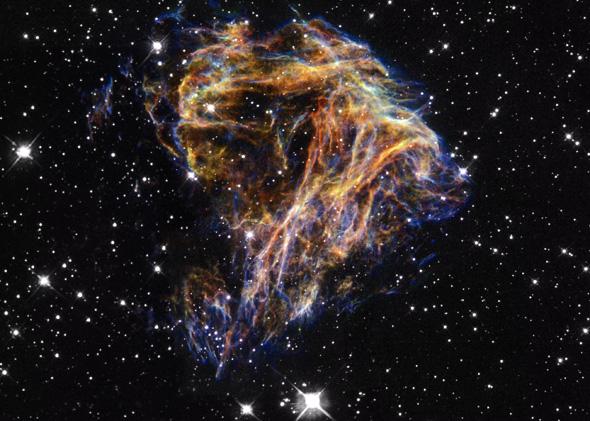Did the universe begin with a black hole in a higher-dimensional reality?
Depending on your level of cynicism, that question sounds like either an exciting idea or something you might hear from the stoner in your social circle. The reality: It’s a bit of interesting but speculative science from physicists attempting to solve a somewhat obscure problem in cosmology. Despite media coverage in Nature (later picked up by PBS and io9), the paper describing the research is unpublished and doesn’t correspond to existing observations. It’s still an interesting idea—one that can help us understand the study of our universe.
Over the past century, astronomers discovered that the universe is expanding. In the distant past, matter was compressed into a hot, opaque plasma with no stars. It expanded into what we see today, with the distance between galaxies growing larger with time. These observations and their theoretical description are known as the Big Bang model, a remarkably successful explanation for a wide variety of phenomena.
However, there’s a limit to our knowledge. Because the universe was opaque during its earliest times, we have only indirect information about what happened then. The more distant an object is from us, the farther back in time we’re seeing it, since light takes time to travel. We eventually reach a point where everything in the observed cosmos may have been compressed into a single point—but that’s not something we can see.
The infinite compression—called the Big Bang singularity—is problematic for many people, and for good reason. While infinity is fine in math, it causes some problems in physics, so a lot of researchers have tried to remove the singularity.
That’s the motivation for the recent paper by Razieh Pourhasan, Niayesh Afshordi, and Robert B. Mann. Their proposal begins with the hypothesis that our universe is actually embedded in a higher-dimensional reality, much as a photograph or (more appropriately) a hologram compresses three dimensions onto a two-dimensional surface. The force of gravity extends into the dimensions we can’t observe, but light and matter are confined to the four dimensions of space and time that we know.
This scheme, known as a braneworld, is not a new idea. (“Brane” is short for “membrane,” the concept being that our observable universe is a kind of membrane with other dimensions extending from it.) Braneworlds are a possible way to understand phenomena like the Big Bang singularity and also the acceleration of the universe, which is caused by a substance called dark energy. Fascinating as they are, though, braneworlds so far predict things that don’t gel with reality—faster-than-light particles or other pathological entities, for instance—or they otherwise fail to produce characteristics that fit with the observed Universe.
The new paper postulates that the Big Bang singularity is actually akin to a black hole in the braneworld scheme. A black hole—which is a well-studied and real type of object in our universe—consists of mass packed into a sufficiently small volume until it becomes so dense and has such a strong gravitational pull that it becomes surrounded by a boundary called an event horizon. Nothing falling past the event horizon can return to the outside universe, including light. The event horizon is what defines a black hole in any meaningful sense. The event horizon prevents us from directly observing a black hole’s singularity: the hypothetical point or ring at the center where all the mass is concentrated.
In the standard formulation, the Big Bang singularity has no event horizon, since it’s difficult to define an “inside” and “outside” when talking about the whole universe. However, in a braneworld the situation may be different. The authors of the new paper propose that a kind of higher-dimensional “star” collapsed to form an event horizon, just as high-mass stars die to form black holes, and that collapse produced our observable universe. According to this theory, the event horizon of the cosmos is a boundary beyond which we’re unable to observe, masking the Big Bang singularity from us. (As a bonus, this proposal solves many problems in other braneworld models.)
However, there’s a significant difficulty. As the authors themselves point out in the paper, their braneworld “white hole” model predicts a small but measurable fluctuation in the density of the Universe—and current observations from the Planck mission have already ruled out that possibility.
Even if a refined version of the braneworld white hole theory solves its immediate problem, it won’t overthrow the prevailing Big Bang model. The confusion lies in the language we use. The term “Big Bang model” describes an extensive set of observations—including the way galaxies are moving apart; the light left over from when the universe became transparent; and the relative number of hydrogen, helium, and lithium atoms—yet the term is also used to describe the initial singularity. However, that singularity is not essential to the Big Bang model.
No matter how cool it sounds, the braneworld white hole model has a set of challenges before it can be considered a viable explanation for the very early universe. The theory was formulated to solve a problem in braneworld cosmology, which itself may or may not be a meaningful model.
More than that: as with all theories, the braneworld white hole must agree with the existing data, which it currently doesn’t do. The fact that the authors recognize the problem is a credit to them. Exciting ideas must be compatible with observation and experiment, and all scientific theories should be considered provisional, constantly tested by evidence. If the authors can’t reconcile their model with the data, the theory will join many others that seem exciting at first but don’t turn out to correspond to reality.
